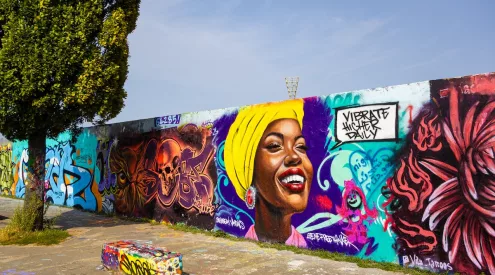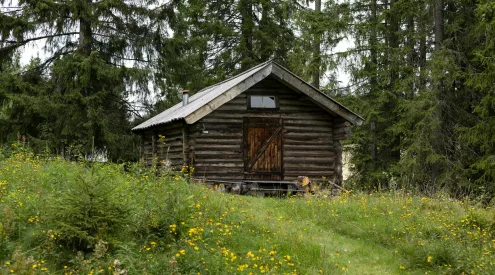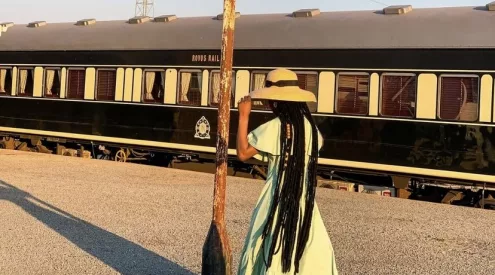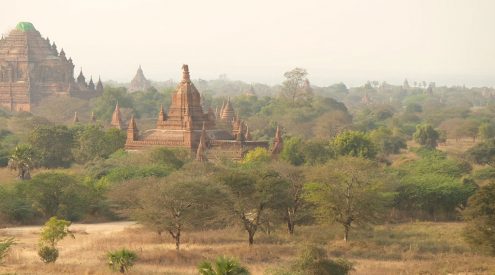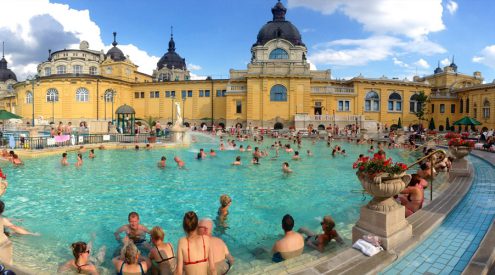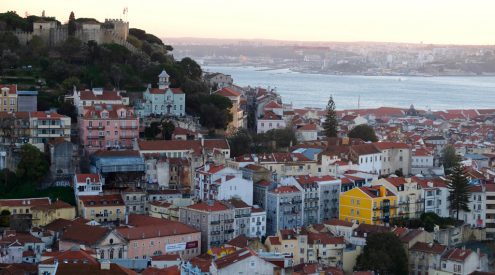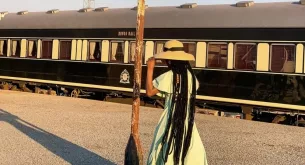The boundary between Northern Ireland and the Republic of Ireland is an invisible one – with no border checks or boundary markers.
You have to watch out for the tell-tale signs. The kilometre per hour signs of the south change to miles per hour signs in the north (which is pretty confusing if you’re doing a self-drive because the rental cars only show miles OR kilometres on the dash). The colour of the number plates and post boxes change (red or green), the town names in the south are in English AND Gaelic, the accent and dialect change completely and the currency goes from euros to pounds at gas stations on the border. Even the colour of the tar changes between north and south according to our driver – though he might have been pulling my leg! The Irish have a great sense of humour.
We headed north on the road up the coast. There are only six counties in the north (including Antrim home to Giant’s Causeway) – and 26 in the south. We took the Causeway coastal route, one of Ireland’s great scenic road journeys. Our destination was Giant’s Causeway, the premier tourist attraction in Northern Island. Opened on 4 July 2012, the new state-of-the-art visitor’s centre there cost 18.5m pounds (over R250m) to build with its exhibits, picture postcard walls of glass, soaring basalt columns and a grassed over roof which all fits organically into the natural landscape.
Giant’s Causeway is a Unesco world heritage site – an awe-inspiring landscape on the northern coast of County Antrim – formed 60 million years ago by volcanic eruptions. Molten lava created these spectacular natural rock formations – over 40 000 interlocking hexagonal basalt columns in weird and wonderful shapes from a giant pipe organ to harp and camel. The tourists queue to sit in the famous wishing seat.
The exhibitions tell the stories of the kings and queens of the causeway like Old Mary who sold water from the giant’s well, secretly adding a tot of whisky to make her refreshment stronger! When novelist William Thackeray visited in 1842, he described it as “a remnant of chaos … savage rock painted a hundred different colours” (lichen). We took a vertiginous walk high up over the cliffs and along the unfenced edge to get a bird’s eye view of the causeway.
I liked the way the high-tech interactive displays in the new visitors centre tell both mythical and geological stories about the origins of the giant’s causeway – including a animated film on a giant screen which depicts the legend of Finn MacCool, the Irish giant who threw down these stones to cross to Scotland and fight a rival giant. When Finn fled back to Ireland, his wife dressed him in baby’s clothes to fool the Scottish giant who thought it was Finn’s baby – and that his opponent must be truly enormous!
The Giant’s Causeway is steeped in myth and legend. I was told to watch out for the “gruagagh” (hairy fairy), Lir (the children of swans), Mac Lir the king of the sea, the sea serpent and “whorl” snail as tiny as a grain of sand. We went from the little people to the little snails! Unable to emulate the giant’s trick of leaping across the sea on giant stepping stones, we crossed the old carrick-a-rede rope bridge swinging over a 30m deep chasm to an offshore island – a little further along the coast.
Now a word about Ireland’s little people. Before setting off from Dublin we went to an evening of Irish folklore at Ireland’s oldest pub at the Brazen Head, a warren of a pub founded in 1198. Ollie Grace, a brilliant storyteller and musician tells stories about Irish rural history, the famine, emigration and “the little people” His band, Barrowside has produced a musical called Kathleen: The Musical Journey of the Irish Emigrant which features old folk songs and has been performed all over the world.
He says “There are three levels of truth in Ireland – things that are true, things that are not true and things that should be true”. When an Irish woman was asked if she believed in the little people, she said “No I don’t – but it doesn’t mean they’re not there!” A guide told me to watch out for the little people’s nursery – which turned out to be a place selling garden gnomes!
Keeping an eye out for the little people, I put salt on my food which is an old Irish trick to keep the mischievous fairies away. I’m not at risk as boys under the age of five are most at risk of being captured by the fairies – which is why superstitious country folk used to dress their young boys in dresses to fool the fairies! Many superstitions about fairies in Ireland go back to pre-Christian pagan beliefs.
If you do come across a leprechaun on the road somewhere in Ireland, they say you only get to ask one question – “Where’s the pot of gold?”. You have to keep eye contact, or they disappear in a puff of smoke! Many farmers don’t cut down the hawthorne trees in the middle of their fields because the fairies are believed to live there – and in what they call a “fairy rath” (a prehistoric hill fort). And in defence in a murder trial years ago, the accused said “The fairies made me do it!”
The Bushmills Inn flew the South African flag to honour our media visit. This old coaching inn (1608) is one of the most atmospheric pubs in Ireland with peat fires, gas lamps and a round tower with a secret library. They have a collection of 300 flags in a flag room – and flew the SA flag the day we visited. They specialise in traditional Irish fare served in old wooden booths in the 17th century stables. You order a gamekeeper’s lunchbox or a pheasant beater’s nosebag with local artisanal cheeses and meats – a “wee starter” like a “brotchan” (an “aitin ‘n drinkin’ soup) or a hot bush toddy (Bushmills with sugar, lemon and cloves). They have really cosy rooms too.
We did a walking tour of Derry, the walled city (1614), also known as Londonderry, designated as UK City of Culture in 2013 – now simply called “legenderry” by the locals! The city is famous for its Bogside murals – and as the site of the Bloody Sunday shootings of 1971. I walked across the spectacular new peace bridge built over the Foyle river between the Protestant and Catholic quarters. We also visited Donegal – a wild landscape of O’Donnell chieftains, castles and heather and gorse moors. The exquisite gardens and historic manor-house at Glenveagh national park are well worth visiting.
We finished our road-trip at a new tourist attraction – the Slieve League Visitor’s Centre. On the north-western tip of Ireland, we went for a walk on the 600m high cliffs, some of the highest in Europe with spectacular views and Celtic ruins. A word of warning though – watch out for unmarked sheep crossings on these misty roads!
I was a guest of TOURISM IRELAND, tel 011-442-0822, [email protected], www.discoverireland.com.

Vertigo - the carrick-a-rede rope bridge on the causeway route, Northern Ireland

The Giant's Causeway, County Antrim, formed 60 million years ago

Hexagonal basalt columns, the giant's stepping stones

The organ pipes at Giant's Causeway

Lunch at Bushmills Inn, near the oldest distillery in the world (1608)

Watch out for sheep on the misty roads of Ireland

Donegal Castle - lair of the O'Donnell chieftains for centuries

Slieve-League on the northern tip of Ireland, some of the highest cliffs in Western Europe

Derry - city of culture 2013

The peace dove, Bogside mural, Londonderry

